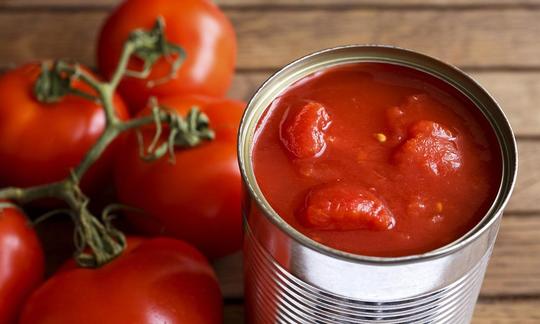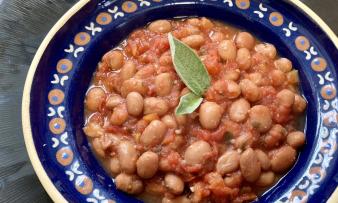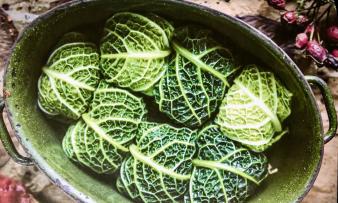Table of contents
Tomatoes ( Solanum lycopersicum) are also available chopped and preserved, often in organic quality. They are used in sauces, soups and stews, among other things.
Use in the kitchen
Tomatoes can be processed in many different ways. In addition to tomato paste or passata, chopped tomatoes are also available - preserved in cans or jars. These come in different varieties, although the consistency depends on the product in question. Some are soft and watery, others are a little firmer and mixed with tomato paste. The contents of some cans are similar to those of tomato sauce. The more tomato paste you add, the stronger the flavor.
Because the tomatoes have been heated for preservation (eg boiled down), they last much longer in the can than fresh ones. This is why they are a popular "storage item". In addition, the canned tomatoes are more flavorful than fresh tomatoes outside of the tomato season because the former have been able to ripen for a long time in the sun.
Chopped tomatoes are mostly used for preparing sauces (with whole grain pasta), salsas, dips or soups. They can also be used for stews (e.g. chili sin carne, African stew with kidney beans and peanut butter) and casseroles. You can also use canned tomatoes for tomato risotto, shakshuka and Indian tomato curries with chickpeas.
In addition to onions and garlic, fresh or dried herbs such as oregano, thyme, basil or parsley are popular spices for refining tomato sauces. A dash of white wine, red wine or balsamic vinegar gives tomato sauces a special touch.
Can you eat raw tomatoes from a can? The tomato mass in canned tomatoes is always pre-cooked and therefore no longer raw. Even if canned tomatoes are filled using heat, it is recommended to heat the contents again before consumption (see below in the chapter Dangers - Intolerances - Side Effects).
Your own preparation
Tomatoes (or cherry tomatoes) are easy to preserve yourself - whole, chopped, organic, with or without the skin. If you are preserving the tomatoes without the skin, you should make a cross-shaped cut in the underside of the tomato skin. Then place the tomatoes in boiling water for a maximum of 30 seconds so that the tomato skin bursts. Then place them in ice-cold water so that the red color remains and the skin comes off easily. Remove the tomatoes and carefully peel off the skin with a paring knife. Then fill the peeled tomatoes, whole or chopped into pieces, into sterile jars. Close the well-filled jars and place in a large saucepan with the bottom lined with newspaper. Fill the pan with water until all the jars are covered. Bring the water to the boil and cook for approx. 30 minutes. Then remove the jars and leave to cool. Check that the snap lock on the lid is bent inwards after cooling.
If desired, you can also refine the preserved tomatoes with herbs.
Vegan recipe for Shakshuka with chopped tomatoes
Ingredients (for 4 people): 1 onion, 1 garlic clove, ¼-½ chili pepper, 2 red bell peppers, 2 tsp cumin (ground), 1 tsp paprika powder (sweet), 2 tbsp tomato paste, 800 g chopped tomatoes (2 cans, organic), 1 tbsp rapeseed oil, some salt andpepper.
Additionally: 200 g vegan feta (e.g. from tofu), 15 g fresh parsley, flatbread.
Preparation: Peel and finely chop the onion and garlic clove. Rinse the chili pepper and cut into fine rings. Wash the sweet peppers and cut into strips. Heat the oil in a pan and briefly sauté the onion, garlic and spices (cumin, paprika). Add tomato paste and sauté for 2-3 minutes. Add the peppers and chopped tomatoes from the tin and simmer for at least 20 minutes until the liquid from the tomatoes has evaporated. Season the creamy shakshuka with salt and pepper. If you like: Crumble the vegan feta in a bowl. Rinse the parsley, shake dry and chop roughly. Remove the vegan shakshuka from the heat, top with vegan feta and parsley and serve with fresh flatbread.
Vegan recipes with tomatoes (chopped, canned) can be found under the note: " Recipes that have the most of this ingredient ".
| Not only vegans or vegetarians should read this: Vegans often eat unhealthily. Avoidable nutritional errors. |
Purchasing - Storage
Tinned tomatoes are available all year round in all supermarkets (e.g. Coop, Migros, Denner, Volg, Spar, Aldi, Lidl, Rewe, Edeka, Hofer, Billa). Organic supermarkets (e.g. Alnatura, Denn's Biomarkt) also sell chopped organic tomatoes in cans or jars.
You can find preserved tomatoes in stores called 'polpa'. These can be chopped (polpa di pomodoro in pezzi) or whole, usually peeled tomatoes (pomodori pelati). Some suppliers also describe the contents as "tomato pulp", and tomato juice is often added. Occasionally you can find the product refined with basil or other herbs. Please read the list of ingredients, as salt or preservatives (acidity regulator citric acid E330) are often included. We provide information below about possible confusion with other tomato products.
The availability of preserved tomatoes (chopped) varies depending on the size of the store, catchment area, etc. Our recorded food prices for the DA-CH countries can be found above under the ingredient image - and by clicking you can see their development at various suppliers.
Storage tips
Canned goods should be stored at a temperature of 8 °C to 19 °C. The minimum shelf life of canned tomatoes is usually one to two years. If you don't need the whole amount of chopped tomatoes at once, you should transfer the leftovers to a well-sealable storage container and store them in the refrigerator. The leftovers should be used up within three days.
If a can shows external changes, such as rust or a curved lid or bottom, the product should no longer be used and should be disposed of unopened. If canned goods smell or taste metallic, rotten or fermented, the contents are no longer edible. With tomatoes in a jar, the "cracking sound" when opened is a sure sign that the vacuum has been broken.
Ingredients - Nutritional values - Calories
100 g of chopped and preserved tomatoes contain 7.3 g of carbohydrates and have an energy content of 32 kcal. Preserved tomatoes are rather low in protein with 1.6 g of protein per 100 g and have a low fat content (0.28 g/100g). 1
Potassium is contained in canned tomatoes at 293 mg/100g - that makes up 15% of the daily requirement. A similar amount can be found in fresh carrot juice and raw, unpasteurized sauerkraut. Kombu seaweed (6100 mg/100g) and dried tomatoes (3427 mg/100g) contain significantly more potassium. 1
100 g of canned tomatoes (chopped) contain 9.2 mg of vitamin C (ascorbic acid) (12% of the daily requirement). Plums and pumpkins have similar levels. The vitamin C content of fresh tomatoes is slightly higher at 14 mg/100 g (17% of the daily requirement). Yellow bell peppers have a significantly higher value at 184 mg/100 g. 1
0.15 mg of vitamin B6 (pyridoxine) can be found in 100 g of tomatoes (chopped, preserved), which is 11% of the daily requirement. This content can be compared with that of fresh kohlrabi and carrots. Pistachios contain 1.7 mg/100g, which is about 11 times as much vitamin B6. 1
The total ingredients of chopped tomatoes (canned), the coverage of the daily requirement and comparison values with other ingredients can be found in our nutrient tables. In the article Nutrients explained you will get a detailed insight into the topic.
Health effects
Are canned tomatoes healthy? The health effects of canned tomatoes can be attributed mainly to the secondary plant substances they contain.
Secondary plant substances
Our article on secondary plant substances provides an overview of the classification of substance groups, their occurrence in food and possible effects on humans. Canned tomatoes contain the following secondary plant substances, among others: 5,14,15
- Isoprenoids: Tetraterpenes: Carotenoids (carotenes: beta-carotene, alpha-carotene, lycopene; xanthophylls: lutein)
- Polyphenols: Phenolic acids: hydroxybenzoic acids (protocatechuic acid, vanillic acid, syringic acid), hydroxycinnamic acids (chlorogenic acid, caffeic acid, p-coumaric acid, ferulic acid); flavonoids: flavanols (catechin), isoflavones (genistin, daidzein), flavanones (naringin, naringenin), flavonols (quercetin, kaempferol, quercetin-3-glucoside, kaempferol 3-glucoside, rutin, isorhamnetin 3-rutinoside, myricetin), flavones (vitexin, diosmin, apigenin); tannins (ellagic acid)
However, it should be noted that the composition of secondary plant substances in canned tomatoes can vary depending on the variety, time of harvest and growing conditions. The processing method chosen can also affect the content of bioactive substances. 14,15 Therefore, quantities are only of limited use and should only be understood roughly.
The tomato is a rich source of nutrients such as carotenoids, flavonoids and phenolic acids. It is the main source of lycopene, which is associated with many health benefits, such as anti-cancer and cardiovascular protective effects. 5,15 Our article Tomato (raw) provides information on the composition of the bioactive substances in fresh tomatoes. This also contains further information on the health effects of raw tomatoes.
Apart from the influence of variety and environment on the accumulation of bioactive compounds, their content in processed tomato products also depends on the manufacturing method, which can either contribute to the release of the compounds or degrade them. 15 However, different measurements give different results regarding the content of phytochemicals in fresh and preserved tomatoes. A study from 2002 shows that thermal processing increases the total antioxidant activity and bioavailable lycopene content in tomatoes without causing significant changes in the content of phenols and flavonoids. Lycopene concentration is thought to increase with heating, as this releases lycopene from its natural cell matrix and makes it available. Only a loss of vitamin C was observed with heating. 16
The results of more recent studies indicate that cooking can significantly reduce polyphenol content, although the loss varies depending on the cooking method. It turns out that quercetin content decreases sharply during cooking, while carotenoid concentration remains stable or even increases in tomato products such as tomato paste. 15
A 2022 review study that brings together various studies shows that general statements about phytochemicals in processed tomato products are difficult. Industrial processing has different effects on nutrients, depending on the processing method and the tomato variety. Nevertheless, it can be said that some compounds, such as lycopene, are often found in higher concentrations in processed tomato products for the same amount consumed (although not in all processed products). Other compounds, such as alpha-carotene, are often more concentrated in fresh tomatoes (although again not in all fresh tomatoes). 14
Despite the differences in these studies, it seems clear that the health effects of processed tomato products may be similar or even greater than those of raw tomatoes, particularly in terms of lycopene content. 15
Dangers - Intolerances - Side effects
Are canned tomatoes harmful to health? Bisphenol A (BPA) is a plasticizer for plastics. It is used as an inner coating of metal cans so that the contents of the can and the metal do not come into direct contact. 2 BPA is a hormone-active substance. In high doses, it has a toxic effect on the liver and kidneys and causes changes in the structure of mammary glands in rodents. 3 A 2019 study examined the BPA concentration in human urine and found that it increased after eating canned food. However, a one-day washout phase is effective in limiting BPA exposure. 4
According to the Swiss Federal Office of Public Health, the effects of BPA at low concentrations are unclear. According to current knowledge, BPA does not pose a health risk because the exposure to the population is too low. However, this statement is the subject of controversial discussion. 3
In 2018, Kassensturz and Saldo tested 14 canned tomatoes in the laboratory and were unable to detect BPA in any of the products tested.
In food botulism, bacteria (including Clostridium botulinum) produce neurotoxins due to insufficient heating, which are a highly toxic metabolic product. Bacterial spores germinate under anaerobic conditions, which manifests itself in canned goods, for example, in swollen lids or cans. The neurotoxins are heat-labile and can be destroyed by subsequent heating. Nevertheless, it is advisable not to use swollen, obviously damaged or foul-smelling canned goods. 13
Ecological footprint - animal welfare
In the off-season, it makes environmental sense to buy preserved tomatoes instead of fresh tomatoes grown in greenhouses. Fresh tomatoes should be purchased during the season if possible, ideally from open-air cultivation. In Switzerland, tomatoes grow in greenhouses (unheated) or outdoors between July and September. These tomatoes have the best ecological balance (due to the avoided emissions from heating with fossil fuels). 8 In addition, people prefer to buy organic products because they have been produced without the use of chemical pesticides and fertilizers.
Preserved tomato products such as chopped tomatoes or passata can be found in cans, jars or in composite cardboard (made of paper and aluminum or plastic). The packaging has a different ecological footprint. The German Nature and Biodiversity Conservation Union ( NABU) had the Institute for Energy and Environmental Research ( ifeu) in Heidelberg analyze the environmental impact of various types of packaging. For processed tomatoes, they compared composite cardboard, tin cans and disposable jars with tin lids. Composite cardboard proved to be the most environmentally friendly packaging in this comparison. The reasons for this: cardboard is lighter than tin or glass and therefore saves emissions during transport; and it is largely made of renewable raw materials. A disadvantage of composite cardboard: the production of paper contributes to aquatic eutrophication, i.e. the unnatural accumulation of nutrients in waters that are actually poor in nutrients. Disposable glass and tinplate both perform comparatively poorly. Tinplate is lighter than glass and therefore causes slightly fewer pollutant emissions during transport. 9
However, the CO 2 footprint of preserved tomatoes (only pureed tomatoes are mentioned here) is higher in any form - in a composite carton (1.6 kg CO 2 eq/kg), in a can (1.8 kg CO 2 eq/kg) or in a glass jar (1.9 kg CO 2 eq/kg) - than that of seasonal and regional tomatoes (0.8 kg CO 2 eq/kg). 11
According to the cited source, the water footprint for the production of 1 kg of fresh tomatoes is 214 liters, which is less than the water required for preserved, peeled tomatoes (267 l/kg), for strained tomatoes (713 l/kg) or the water required for tomato paste (855 l/kg). 12
For detailed explanations of various sustainability indicators (such as ecological footprint, CO2 footprint, water footprint), see our article: What does the ecological footprint mean?
Worldwide occurrence - cultivation
The countries that have the highest consumption of canned tomatoes or are at least the most important importers are mostly located within Europe. These include the United Kingdom, Germany and France. The most important non-European markets for canned tomatoes are in Japan and Canada. 6
China is the largest tomato producer in the world. A large proportion of the tomatoes grown there are exported to Italy, where they are processed into canned goods. 7
Possible confusion
What are chopped tomatoes? Chopped tomatoes from canned foods are not the same as strained tomatoes (also called passata). To make passata, tomatoes are finely pureed so that no pieces or seeds can be found; alternatively, you can use a passevite or pass the cooked tomato mixture through a sieve - it is also possible to remove the seeds and skin before cooking. Chopped tomatoes are, as the name suggests, tomatoes that have been cut into pieces and then preserved.
Also, chopped tomatoes are not the same as tomato paste (sometimes called tomato purée), which consists of strained tomato flesh (without the skin and seeds) that has been thickened under vacuum and heat to preserve it.
Industrial production
A typical commercial preservation operation uses the following processes: 10
- Wash
- Sorting, Classifying
- Preparation (peeling, cutting, possibly coring)
- Filling into containers
- Common additives: 0.1-0.2% citric acid (E330), 2-3% sucrose (sugar) and salt.
- Venting and closing the containers
- Heat sterilization
- Cool
- Packaging (labeling) and storage (for shipping)
More information
The main goal of food processing is to preserve perishable foods in a stable form so that they can be stored and used throughout the year. Why preserve tomatoes? The purpose of the preservation process is to kill all microorganisms in the food and prevent re-contamination by microorganisms. Heat is usually used to kill microorganisms. To prevent the growth of microorganisms that require oxygen, oxygen deprivation (in conjunction with other methods) can be used. 10
Alternative names
Chopped tomatoes in cans are also known as chopped or chopped tomatoes (from a can). In Austria, tomatoes are colloquially called Paradeiser.
In English, chopped tomatoes are called diced tomatoes, preserved tomatoes, and canned tomatoes.
Bibliography - 16 Sources
| 1. | USDA United States Department of Agriculture. |
| 2. | Srf.ch Dosenpelati-Test: Nicht alle Tomaten aus der Konserve überzeugen. 2018. |
| 3. | Bundesamt für Gesundheit BAG. Bisphenol A. Bericht. 2020. |
| 4. | Peng CY, Tsai EM, Kao TH, Lai TC, Liang SS, Chiu CC u. a. Canned food intake and urinary bisphenol a concentrations: a randomized crossover intervention study. Environ Sci Pollut Res Int. 2019;26:27999–28009. |
| 5. | Izzo L, Castaldo L, Lombardi S, Gaspari A, Grosso M, Ritieni A. Bioaccessibility and antioxidant capacity of bioactive compounds from various typologies of canned tomatoes. Front Nutr. 2022;9:849163. |
| 6. | Tomatonews.com Canned tomatoes: global market situation in 2020. |
| 7. | Planet-wissen.de Die Tomaten-Industrie. |
| 8. | Zhiyenbek A, Beretta C, Stoessel F, Hellweg St. Ökobilanzierung Früchte- und Gemüseproduktion. ETH Zürich. 2016. |
| 9. | Geo. de Karton, Glas, Dose – wie sind verarbeitete Tomaten am besten verpackt? 2021. |
| 10. | EPA U.S. Environmental Protection Agency Emission Factors. Food And Agricultural Industries. Section 9.8.1 Canned Fruits And Vegetables. 1995. |
| 11. | Reinhardt G, Gärtner S, Wagner T. Ökologische Fussabdrücke von Lebensmitteln und Gerichten in Deutschland. IFEU Institut für Energie - und Umweltforschung Heidelberg. 2020. |
| 12. | Mekonnen MM, Hoekstra AY. The green, blue and grey water footprint of crops and derived crop products. Hydrol. Earth Syst. Sci. 2011; 15: 1577-1600. |
| 13. | Robert Koch Institut. Botulismus. RKI-Ratgeber. 2022. |
| 14. | Wu X, Yu L, Pehrsson PR. Are processed tomato products as nutritious as fresh tomatoes? Scoping review on the effects of industrial processing on nutrients and bioactive compounds in tomatoes. Advances in Nutrition. 2022;13(1):138–151. |
| 15. | Martí R, Roselló S, Cebolla-Cornejo J. Tomato as a source of carotenoids and polyphenols targeted to cancer prevention. Cancers. 2016;8(6):58. |
| 16. | Dewanto V, Wu X, Adom KK, Liu RH. Thermal processing enhances the nutritional value of tomatoes by increasing total antioxidant activity. J Agric Food Chem. 2002;50(10):3010–3014. |











Comments